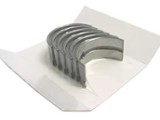"Turbo" main bearings (Now more often called Center Tang bearings) were designed by Leyland’s engineers to meet a perceived need. It was decided probably by both theoretical calculation and practical test that the Turbo Metro engine with its increased bearing loads needed a better bearing, so what they did was remove the oil groove from the bottom bearing shell giving roughly 30% more bearing area. The center tang bearing can now be found in many later model A+ engines.
It is claimed that this gives about 80% more load carrying capacity, exactly how 30% more area gives an 80% increase in capacity I’m not sure but this figure is widely claimed in both Minis and other engines and is not disputed. O.K if it is possible to remove this groove one must wonder why it was there in the first place? To explain that you need to know a little of how the engines lubrication system works; Oil is pumped through galleries in the block to the main bearings, it passes through a hole in the bearing into the aforementioned groove, from here it flows sideways across the bearing, some of it leaking out the sides, the rest is forced into holes in the crank, travels through the crank and exits through a hole in the big end journal where it lubricates the big end / connecting rod bearing before leaking out the sides.
Now the next step is to think about what happens if we remove one of these grooves, remembering that turbo bearings still have a grooved top bearing. As the hole in the crank passes the grooved top bearing oil flows through the crank to the big end, no worries here but as the hole passes across the non- grooved shell there is only a gap of 0.002" for the oil to flow through therefore very little if any oil is fed to the big ends during half of every revolution, whether there is sufficient residual oil is debatable I think there isn’t. O.K. so why don’t all the turbo Metro engines suffer bearing failure? The reason is the main bearing journals are "through drilled" that is to say that they have two oil holes 180 degrees apart so while one hole is in the non-grooved bearing the other hole lines up with the grooved bearing.
Classic Mini center tang main crankshaft bearings
Related Parts
-
VPM91886-30CList: $59.98SAVE: $32.25Clearance Price $27.73
-
VPM91886-STDRList: $71.98SAVE: $30.13Clearance Price $41.85
-
VPM91886-10$71.95
-
VPM91886-20R$59.98
-
VP91885-STD$48.95
-
VP91885-STDR$71.98
-
VP91885-10$78.95
-
VP91885-10R$79.95
-
VP91885-20$78.95
-
VP91885-20R$59.98
-
VPM91886-10C$53.98
-
VPM91886-10R$59.98
-
VPM91886-30R$75.98
-
VPM91886-20C$59.98
-
VPM91886-STDC$71.98
-
VPM91886-STD$79.95
-
VPM91886-30$96.98
-
VPM91886-20$70.95
-
VP91885-30No Longer Available
-
VPM91886-40C
Please Wait








